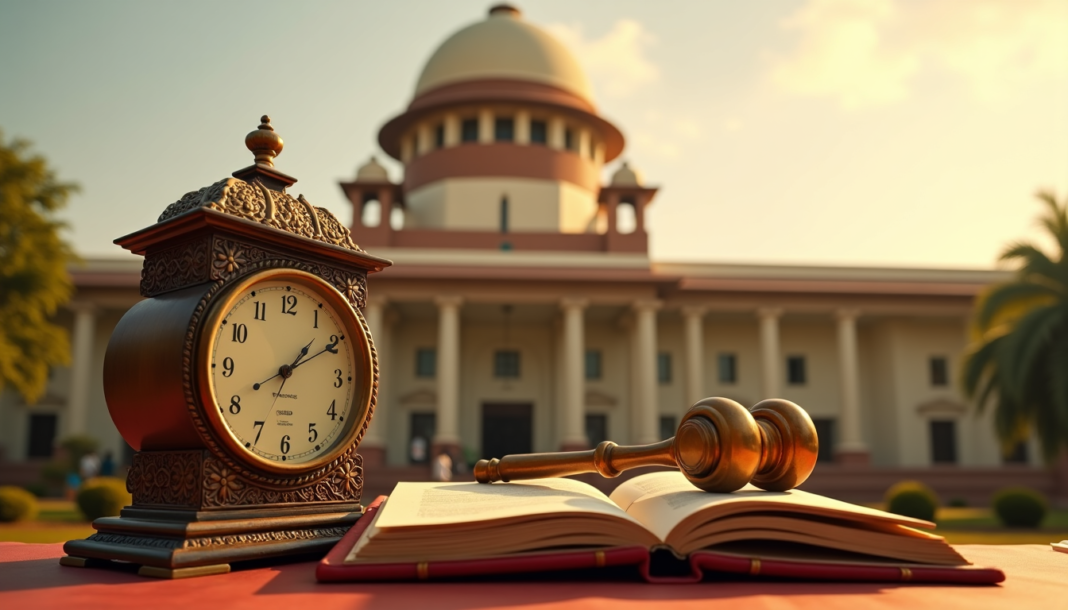The Tamil Nadu Governor’s three-year delay in clearing significant bills has ended with a historic Supreme Court precedent. Ten bills repeatedly passed by the Tamil Nadu assembly have become laws. This development marks a defining moment in Indian democracy. Supreme Court intervention
The Supreme Court’s groundbreaking ruling requires the Tamil Nadu Governor to act on bills within 30 days, while the President gets three months to make decisions. This judgment stops governors from becoming “super constitutional figures” who could endlessly delay the legislative process. The ruling will affect Tamil Nadu and set a precedent for state governments nationwide. Chief Minister MK Stalin celebrated this as a historic victory for democracy.
Table of Contents
Supreme Court Interprets Article 200 to Curb Gubernatorial Overreach
The Supreme Court’s review of Article 200 has clearly cut back gubernatorial powers in a judgment that changes India’s federal structure. Justice J.B. Pardiwala wrote a detailed interpretation for the bench that stops governors from using them as political weapons against state legislatures. Constitutional provisions
Justices Clarify Constitutional Limitations on Governor’s Powers
The Court’s landmark ruling firmly rejected the idea that governors have discretionary powers when handling state bills. The judgment states that a governor cannot reserve bills for presidential review based on “personal dissatisfaction, political expediency or any other extraneous considerations”. Constitutional courts will immediately strike down such actions.
The bench took apart the idea of “absolute veto” or “pocket veto.” It made clear that governors who withhold assent without good reasons violate constitutional principles. The judgment warned that letting governors have unlimited power to withhold or reserve assent would “turn them into super-constitutional figures who could completely stop the state’s legislative machinery” [2].
Court Establishes Strict Timeline for Executive Actions
One of the most important parts of the ruling sets strict timelines – something new in Indian constitutional history. The Court laid down these specific timeframes for governors:
- When following the Council of Ministers’ advice: Assent must be granted or bill reserved within one month
- When withholding assent against ministerial advice: Bill must be returned with a message within three months
- When reserving bills against ministerial advice: The Reservation must occur within three months
- For bills re-presented after reconsideration: Assent must be granted within one month
The ruling also makes the President accountable. Presidential decisions on referred bills must come within three months from receipt. The state must receive proper reasons for any delay beyond this period.
How the Judgment Redefines Presidential References
The Court created a groundbreaking principle about presidential references. Justice Pardiwala suggested that the President should ask for the on bills that governors reserve due to possible unconstitutionality. Supreme Court’s opinion
The judgment compared this to Sri Lanka’s system, where their President must send bills to their Supreme Court when constitutional questions come up. This method “saves time and public money by preventing litigation and delays that happen when faulty Bills become laws” [5].
In spite of that, the Court warned against using this preventative step to “thwart the legislative powers of the States” [5], which helps maintain India’s federal structure balance.
Why Did the Court Invoke Extraordinary Powers Under Article 142?
The Supreme Court took an extraordinary step by using its special powers to resolve an unprecedented constitutional stalemate. This article lets the Court deliver “complete justice” in cases before it. The Court used this rarely invoked provision to break what it called a deliberate “roadblock” created by the Tamil Nadu Governor. Article 142 of the Constitution
Unprecedented Declaration of ‘Deemed Assent’
Indian democracy witnessed a historic first when the Court declared that the Tamil Nadu Assembly’s 10 Bills had “deemed to have received assent” on November 18, 2023. This happened when the bills were re-presented to the Governor after being repassed. The Tamil Nadu Government made these 10 Acts official by publishing them in the state gazette. Never before had a state government implemented laws based on a Court order instead of the Governor’s formal approval.
The notifications mentioned the Supreme Court’s April 8 judgment specifically. The judgment stated that a Governor must constitutionally approve a bill once the legislature repasses it after initial return. Justice Pardiwala explained that this unusual intervention was needed to protect constitutional integrity from endless delays in the legislative process.
Judicial Response to Repeated Constitutional Violations
The Court noticed a pattern of constitutional violations by the Governor and decided these exceptional measures were necessary. The bench found it had “no choice” after determining the Governor’s actions were “lacking in bonafides”. Justice Pardiwala pointed out several “clear instances where the Governor failed in showing due deference and respect to the judgments and directions of this Court”.
The Court found it especially concerning that the Governor returned Bills without explaining why. This directly violated the Court’s binding directive from a 2023 Punjab case. The bench stated they found it “difficult to repose trust” in the Governor to properly follow its directives.
Some critics called this intervention “judicial overreach”. However, constitutional experts like P.D.T. Achary, former Secretary General of the Lok Sabha, supported the ruling. They saw it as upholding federalism principles and giving opposition-ruled states a clear solution against gubernatorial delays. Chief Minister Stalin celebrated the verdict as “a victory not just for Tamil Nadu but all state governments in India”.
Court Traces Evolution of Judicial Approach to Governor’s Powers
The judiciary’s stance on gubernatorial powers has changed remarkably over the last several years. Simple suggestions have now become strict constitutional boundaries with clear timelines.
From Gentle Reminders to Strict Mandates
They took a cautious approach to gubernatorial delays at first. The judiciary chose to defer and diffuse tensions through wise counsel rather than direct intervention because they were dealing with high constitutional authorities. This careful approach showed the Court’s usual reluctance to step into constitutional appointees’ functions. The Court’s patience began to wear thin as patterns of calculated delays emerged in multiple states, which led to more assertive interventions. Supreme Court
Telangana and Punjab Cases Set the Stage
The Court’s progress picked up speed in April 2023 with the Telangana Governor case. The bench simply “reminded” the Governor that Article 200 required decisions on bills “as soon as possible”. The Court took a stronger position in November 2023 with the Punjab Governor case after this gentle reminder went unheeded. It noted that governors, as unelected heads, could not veto legislatures by withholding assent. The Punjab judgment required governors to return bills with reasons if they chose to withhold assent. The Court stated during this hearing that it hoped to send a “strong message” to Tamil Nadu and Kerala’s governors, who faced similar petitions.
Tamil Nadu Case Delivers the Final Blow to ‘Governor Raj’
The Tamil Nadu case marked the peak of this judicial progress—delivering what legal experts called the “final blow to Governor Raj”. The Court had to be assertive “not by choice, but by necessity”—responding to “repeated, brazen disregard of its earlier appeals”. The Governor’s conduct during litigation “lacked bonafides” with “clear instances where the Governor failed in showing due deference and respect to the judgments and directions of this Court”. This breach of trust made the extraordinary remedy of deemed assent necessary.
The Court made it clear that governors are not “super-constitutional figures” who can “collude with the Union Cabinet”. This statement established new limits for gubernatorial discretion. Governors across India must now work within strict judicial guidelines. They must serve as constitutional facilitators instead of political obstructionists.
Legal Experts Debate Far-Reaching Implications for Indian Federalism
Constitutional experts in India have started to examine how the Tamil Nadu governor’s verdict could reshape the country’s federal structure in the coming decades.
Constitutional Scholars Analyze Judgment’s Effect
P.D.T. Achary, former Secretary General of the Lok Sabha, believes the ruling upholds federalism by giving “a clear constitutional remedy against inordinate delays by Governors”. Senior advocate Shadan Farsat points out that the Court’s rare use of inherent powers creates a legal fiction of “deemed assent.” This establishes vital safeguards against gubernatorial overreach.
The judgment does more than just criticize one governor. It brings back and makes sure Raj Bhavans work with transparency and accountability. The verdict puts an end to what critics called “Governor Raj,” where appointed officials could hold up elected governments’ legislative plans indefinitely. Constitutional morality
Potential Challenges to the Court’s Directives to the President
Many experts support the judgment. However, some raise concerns about the Court issuing directives to the President. One analysis asks, “Could presidential defiance of such a directive mean that the SC could potentially haul up the president for contempt of court?”.
This brings up questions about the separation of powers. The Court’s authority to issue mandamus to the President changes the constitutional position that the President acts only on the Prime Minister’s advice. Some experts also feel a larger Constitution Bench should have heard “a case of this importance” instead of a two-judge bench.
How This Reshapes the Center-State Balance of Power
The judgment improves states’ administrative freedom by stopping governors from delaying legislation “under the pretext of scrutiny” [1]. This rebalancing happens when tensions are high between governors and governments in non-BJP-ruled states, especially regarding university vice-chancellor appointments [1].
Experts think the ruling will change not just Center-state relations but possibly India’s democratic framework. Tamil Nadu’s bold step to notify laws without the governor’s assent sets an example. Other opposition-ruled states might follow this path to assert their autonomy against what they see as central overreach.
The judgment marks a milestone in India’s federal experience. It addresses growing worries about the “breakdown of constitutional order” caused by governors’ politically motivated delays.
Conclusion
The Supreme Court’s landmark verdict has reshaped India’s federal structure. It sets clear boundaries for governors’ powers and protects state legislative autonomy. The new 30-day timeline for governors’ decisions will prevent constitutional deadlocks and help state legislatures work smoothly.
This historic ruling shows how judicial wisdom can balance constitutional principles with real-world governance needs. The Court’s reading of Article 200, along with strict timelines for governors and the President, creates a reliable system that keeps political interference out of legislative processes.
“Deemed assent” now serves as a strong deterrent against attempts to delay state legislation through governor’s offices. The ruling’s impact goes beyond Tamil Nadu and gives constitutional protection to all states that face similar issues.
The verdict strengthens democratic principles by making sure elected representatives’ decisions get reviewed on time. The Supreme Court’s clear intervention has made India’s federal structure stronger. These new guidelines will shape how the center and states work together for years to come.



